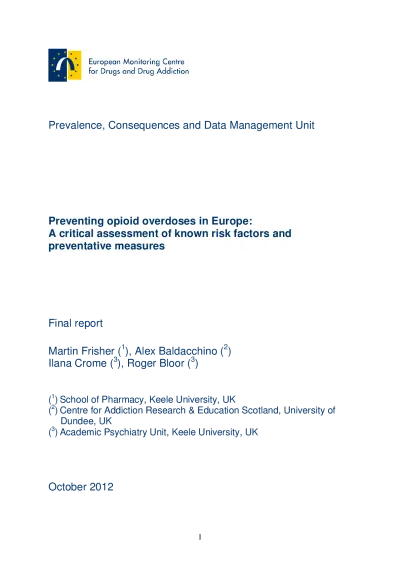Summary
The objective of this report is to review the literature on preventable risks of fatal overdose in heroin users. To the extent that such factors can be identified, prevention and treatment interventions for potentially fatal overdoses can be informed by research findings. Extant reports already make a range of recommendations regarding overdose with one review stating that ‘most overdoses and deaths are avoidable’. However, what ‘avoidable’ means in this context is unclear. Broadly speaking, the current state of knowledge is that the more individual, situational and organisational risk factors that are present, the greater the likelihood that the overdose will be fatal. The degree to which this complex set of factors can be modified in order to reduce fatal overdose is the focus of this report.
Method
There were four steps. 1. Key reviews were identified (see Appendix 1). 2. Using these reviews, the aim was to identify risk/protective factors associated with non-fatal and fatal overdoses. 3. The analysis focused on assessing the impact of non-fatal overdoses on subsequent overdose experience and differentiating fatal and non-fatal opiate overdoses. 4. The information was reviewed by an expert panel at St Andrews University, Scotland in April 2010.The panel considered the efficacy and feasibility of sixteen measures identified by the review.
Key results
The single most important factor for fatal overdose appears to be using other depressant drugs at the same time as illicit opiates. It has previously been suggested that some multifaceted combination of treatment options, e.g. increasing and improving treatment with opiate substitutes, community peer education, family support groups, supervised injecting facilities, and making naloxone available at home may be needed to have any practical effect on mortality from overdose. However, the review identified barriers at several levels; firstly, for drug users themselves, secondly for witnesses, thirdly for service providers and fourthly for society. These barriers need to be overcome in order to reduce overdose. Ultimately, without behavioural change on the part of drug users, there is unlikely to be a significant reduction in the level of fatal overdose. The expert panel also highlighted the fact that overdose is often a symptom of deeper underlying problems in the individual that initiate and exacerbate problematic drug use. Without addressing these problems (e.g. psychiatric conditions, combinations of depressant drugs), the impact of primary overdose prevention may be limited. The panel felt that practical interventions could occur in settings not identified in the literature, for example, when drug users are in police custody. However, there is no current evidence that such interventions do actually reduce fatal overdose.
In summary, there are many reasons for fatal overdoses and the review did not identify any particular measure that is likely to have a significant impact. Rather there is evidence that many interventions may reduce overdose, particularly in settings where the drug user is in contact with treatment or emergency services. However, it is important to bear in mind the distinction between overdose prevention at the clinical and at the population level. At the clinical level, specific interventions are available and have been shown to be effective (e.g. pharmacological treatment). At the population level, where many drug users are not in contact with services, overdose reduction depends on behavioural change by drug users themselves (e.g. avoiding the mixture of opiates and other depressant drugs). Overdose prevention is a multifaceted problem. Purely technological interventions were thought likely to have a relatively limited impact. Rather, overdose involves personal and societal issues; only when these are addressed is the level of fatal overdose in Europe likely to decrease.
Download as PDF
Report
PDF files are made available as a convenience. In cases where the EMCDDA is not the originator of the document, please be aware that any PDFs available on this page may not be authoritative or there may be more recent versions available. While we make every effort to ensure that these files are definitive, before using or citing them, we recommend that you consult the publisher's website or contact the author(s) to check for more recent versions.









